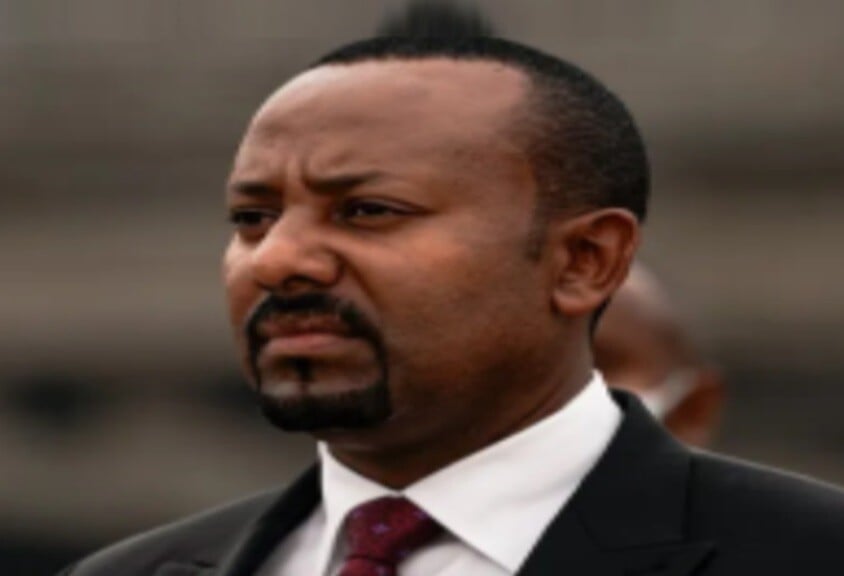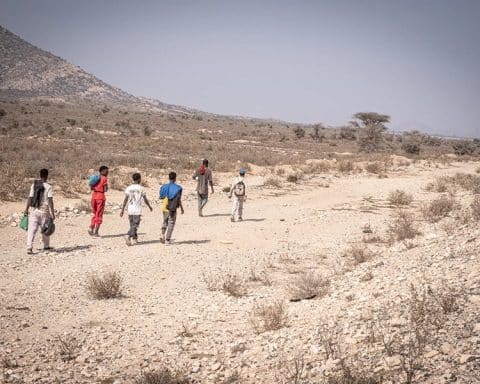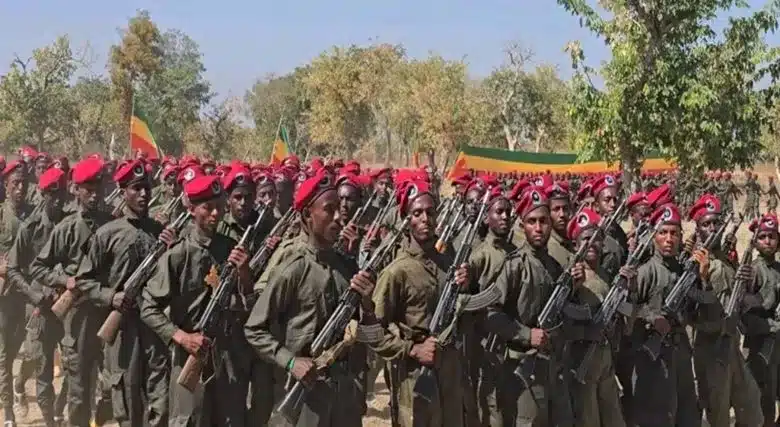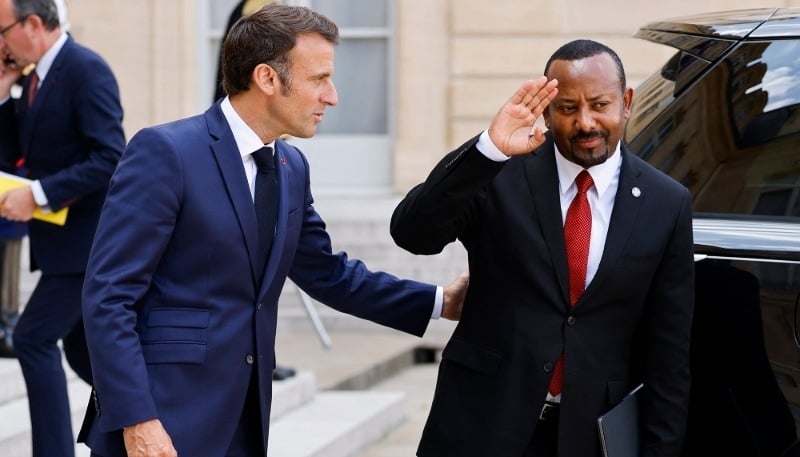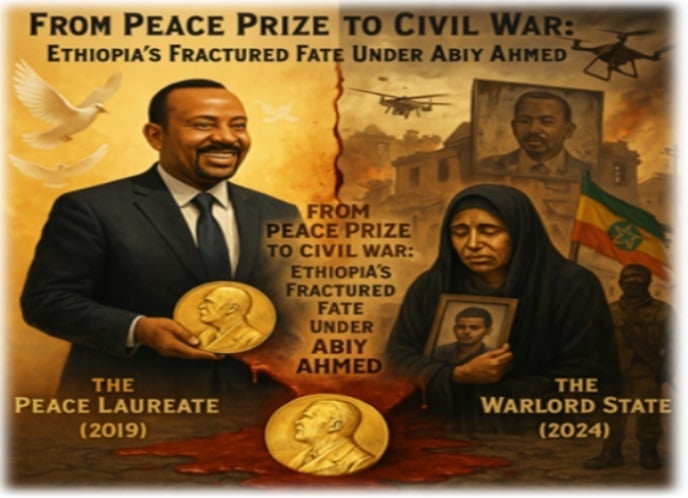
This powerful image captures Ethiopia’s tragic fall from hope to horror. In 2019, Prime Minister Abiy Ahmed was hailed as a Nobel Peace Prize-winning reformer. Today, his rule is marked by civil war, ethnic massacres, and economic collapse. Burned villages, mass graves, and millions of displaced civilians reveal the staggering human cost. The nation’s institutions lie in ruins, and the promise of peace has given way to repression and brutality. This image is more than a reflection of conflict—it is a sobering indictment of premature international acclaim and a haunting reminder of a people’s enduring struggle for justice, unity, and survival.
Caleb Ta (Dr.)
May 29, 2025
Abstract
In 2019, Ethiopian Prime Minister Abiy Ahmed was awarded the Nobel Peace Prize for his initial political reforms and efforts to end a protracted conflict with Eritrea. However, subsequent years saw Ethiopia spiral into civil war, economic decline, and humanitarian catastrophe. This paper critically assesses the premature nature of the Nobel award and examines how Abiy’s tenure has led to systemic instability. It delves into the escalation of violence in the Amhara region, the rise of the Fano movement, and broader regional consequences. The analysis underscores how international accolades, when conferred hastily, can shield authoritarian consolidation and exacerbate conflict.
Introduction
When Abiy Ahmed received the Nobel Peace Prize in October 2019, it was seen as a beacon of hope for Ethiopia and the Horn of Africa. Celebrated for ending the long-standing hostilities with Eritrea and introducing democratic reforms, Abiy was widely lauded. Yet, the award was more aspirational than reflective of systemic change. In the years that followed, Ethiopia descended into some of the most violent and destabilizing crises in its modern history. This paper contends that the Nobel Prize not only legitimized a nascent regime without ensuring accountability but also masked deep-seated structural flaws that later fueled war, repression, and socio-economic collapse.
Initial Reforms and Unfounded Optimism: Power Consolidation Disguised as Reform
Upon assuming office in April 2018, Abiy Ahmed implemented a series of headline-grabbing reforms that earned him swift international acclaim and culminated in the 2019 Nobel Peace Prize. These reforms included the release of thousands of political prisoners, the return of exiled opposition parties such as Ginbot 7, loosening of media restrictions, and the signing of a peace agreement with Eritrea—ending a two-decade-long military stalemate. At face value, these measures suggested a bold departure from the authoritarian legacy of the Ethiopian People’s Revolutionary Democratic Front (EPRDF). However, closer examination reveals these steps were more tactical than transformative, serving to temporarily placate domestic opposition and gain international legitimacy.
By late 2019, Abiy dissolved the EPRDF coalition and replaced it with the centralized Prosperity Party, consolidating authority under his leadership. This restructuring marginalized regional power centers—most notably the TPLF in Tigray, which refused to join the new party—and set the stage for a devastating civil war by 2020. Simultaneously, Abiy militarized governance, assuming direct control over the military, police, and intelligence services, and launched military offensives—including the war in Tigray—without parliamentary approval. These actions marked a decisive shift from liberal reformer to authoritarian ruler. Drone strikes, mass arrests, and violent crackdowns became widespread across Tigray, Amhara, and Oromia, as dissent was increasingly met with state violence rather than dialogue.
Abiy also co-opted or eliminated opposition figures, many of whom had been welcomed back from exile at the start of his tenure, only to be arrested or politically neutralized once they gained popular support. Internationally, Abiy maintained a carefully curated image as a tech-savvy modernizer, which was instrumental in winning the Nobel Prize for a peace deal with Eritrea that soon unraveled. His “Medemer” ideology, promoted as a unifying philosophy, functioned instead as a tool for centralizing power and weakening Ethiopia’s ethnically federalist structure. Far from fostering inclusive governance, Abiy’s administration used the appearance of democratization to entrench executive control, suppress opposition, and catalyze Ethiopia’s descent into authoritarianism, civil war, and institutional fragmentation. Rather than building democratic resilience, power became increasingly centralized, and dissent was suppressed.
From Peace to Conflict: The Civil War in Tigray and Beyond
By November 2020, Ethiopia was engulfed in civil war. A federal military campaign against the Tigray People’s Liberation Front (TPLF) unleashed widespread violence. Reports from Amnesty International, Human Rights Watch, and the UN documented war crimes including mass killings, sexual violence, and intentional starvation tactics.
Key impacts include:
- An estimated 600,000 deaths due to violence, famine, and healthcare collapse (Associated Press, 2023).
- Over 2.5 million people displaced from Tigray (IOM Ethiopia, 2022).
- Humanitarian aid blockades that exacerbated famine and suffering.
After the 2022 Pretoria Agreement ended the Tigray conflict, violence escalated in the Amhara region. The federal government’s dismantling of regional militias like the Fano and Amhara Special Forces sparked resistance and a new wave of violence.
Targeted Drone Strikes in Amhara (2023–2025)
From 2023 onward, the Ethiopian federal government intensified its use of drone warfare in Amhara, often targeting civilian areas. While many incidents remain undocumented, ten major strikes exemplify the scale and severity of the campaign:
- Finote Selam (Aug 13, 2023) – 30 killed, 55+ injured
- Waber (Nov 9, 2023) – 13 civilians killed at a bus stop
- Wegel Tena (Nov 30 & Dec 5, 2023) – 15 killed in separate incidents
- Sasit (Feb 19, 2024) – 30 civilians killed in a truck
- Gerchech (Oct 11–14, 2024) – Over 100 killed in a convoy
- Achefer (Oct 26, 2024) – 50+ killed in a town
- Duberete (Nov 5, 2024) – 30+ killed at a gathering
- Gedeb (Apr 17, 2025) – Over 100 killed
- Ambasel (Feb 13, 2025) – 4 killed, including 3 children
- Zenbo Kebele (Feb 7, 2025) – Pregnant woman and daughter killed
These incidents highlight a pattern of indiscriminate or deliberate targeting of civilians, amounting to violations of international law. Human rights groups have condemned the attacks, yet investigations remain absent.
Ethnic Federalism, Historical Grievances, and State Fragmentation
Ethiopia’s ethnic federal system, established under the 1995 Constitution, has fueled competition for power, land, and representation. Abiy’s administration failed to de-escalate these tensions. Instead, longstanding grievances—particularly among the Amhara—deepened.
- Over 20,000 Amhara civilians were killed in ethnic violence between 2018 and 2024, especially in Oromia, Benishangul-Gumuz, and Metekel.
- Nationwide, ethnic displacement exceeded 4.5 million people (IDMC, 2024).
- Armed conflicts with insurgent groups like the Oromo Liberation Army (OLA) continued to destabilize key regions.
National institutions previously regarded as neutral—such as Ethiopian Airlines and the Commercial Bank—have been accused of ethnic bias and political manipulation under the Prosperity Party.
Massacres of Amhara Civilians in Oromia (2018–2024)
Mass atrocities against Amhara communities in Oromia were carried out by multiple actors, including the OLA, Oromia Special Forces, and federal troops.
Significant incidents include:
- Gimbi (Tole Kebele, June 2022):Over 400 Amhara civilians killed.
- Qelem Wollega (July 2022):At least 150 civilians killed.
- Gida Kiremu (August 2021):150 Amhara civilians killed.
- Abo Church (March 2021):29 civilians killed during worship.
- Gawa Qanqa (November 2020):32–54 killed at a schoolyard.
- Kiremu Town (November 2022):25 civilians killed by OSF.
These events reflect a systematic campaign against Amhara civilians, marked by ethnic targeting, lack of federal protection, and frequent government complicity or negligence.
Institutional Collapse and Ethnic Exclusion
In regions like Benishangul-Gumuz, the constitution recognizes only select ethnic groups, disenfranchising others—especially the Amhara. In the Metekel Zone, armed Gumuz militias, allegedly supported by local officials, have killed hundreds and displaced thousands.
This ethnic exclusion is mirrored in federal institutions, many of which now serve partisan interests. Their politicization has eroded trust, reduced effectiveness, and further fragmented the state.
Economic Collapse and Social Unrest
Once seen as a rising economy, Ethiopia now faces serious economic decline:
- Inflation:Reached 30.2% in 2023, with food inflation over 60%.
- Currency Devaluation:The birr lost more than half its value between 2020 and 2024.
- External Debt:Surged to $28.9 billion by mid-2024, prompting a debt restructuring process.
- Youth Unemployment:High rates have led to mass discontent. A 2024 Afrobarometer survey revealed that most Ethiopian youth believe the country is on the wrong track.
This economic deterioration, coupled with authoritarian repression of civil society, has created fertile ground for unrest.
Humanitarian Emergency and Global Inaction
In 2024, Ethiopia now hosts over 6.8 million internally displaced persons.
- Access to aid is restricted in many conflict zones.
- Hospitals, schools, and marketplaces have been destroyed or repurposed for military use.
- Sexual violence is rampant, with reports implicating all parties to the conflict.
Despite these dire conditions, the international response has been muted. While Western powers have issued statements and suspended some aid, they have taken few concrete steps to enforce peace or accountability. The Nobel Committee has remained silent amid the stark contrast between Abiy’s prize citation and the present reality.
Conclusion
Abiy Ahmed’s rise from reformist leader to authoritarian wartime ruler represents one of the most dramatic democratic backslides in contemporary African politics. His initial portrayal as a transformative figure—culminating in the 2019 Nobel Peace Prize—created a powerful yet ultimately misleading narrative of progress. The international community’s hasty celebration of his early gestures, in the absence of substantive institutional reform or inclusive governance, granted Abiy an aura of legitimacy. This global endorsement not only emboldened him but also helped deflect early scrutiny, enabling the quiet consolidation of power and the erosion of democratic norms.
Rather than healing Ethiopia’s deep ethnic fractures, Abiy’s administration exacerbated them. His government presided over a series of violent internal conflicts marked by war crimes, ethnic cleansing, and the mass displacement of civilians—particularly in Tigray, Amhara, and Oromia. Core institutions that once symbolized national unity deteriorated into politicized tools of repression, while the country’s economic foundations unraveled under the weight of war, inflation, and mismanagement. What was once viewed as a promising model for African democratization has become a cautionary tale of centralized rule and unchecked ambition.
Ethiopia’s internal turmoil now poses significant risks to regional stability in the Horn of Africa, a region already beset by fragility. The consequences of Abiy Ahmed’s governance extend far beyond national borders, contributing to geopolitical volatility and humanitarian crises. His trajectory echoes other globally celebrated leaders—such as Aung San Suu Kyi in Myanmar and Recep Tayyip Erdoğan in Turkey—who began with reputations as reformers but ultimately entrenched authoritarian rule. These cases underscore the dangers of premature international accolades and highlight the urgent need for more measured, accountability-based approaches to global recognition. Ethiopia’s future, and that of the wider region, will depend on a renewed commitment to inclusive governance, justice, and reconciliation—led not by symbolism, but by sustained, substantive reform from within.

